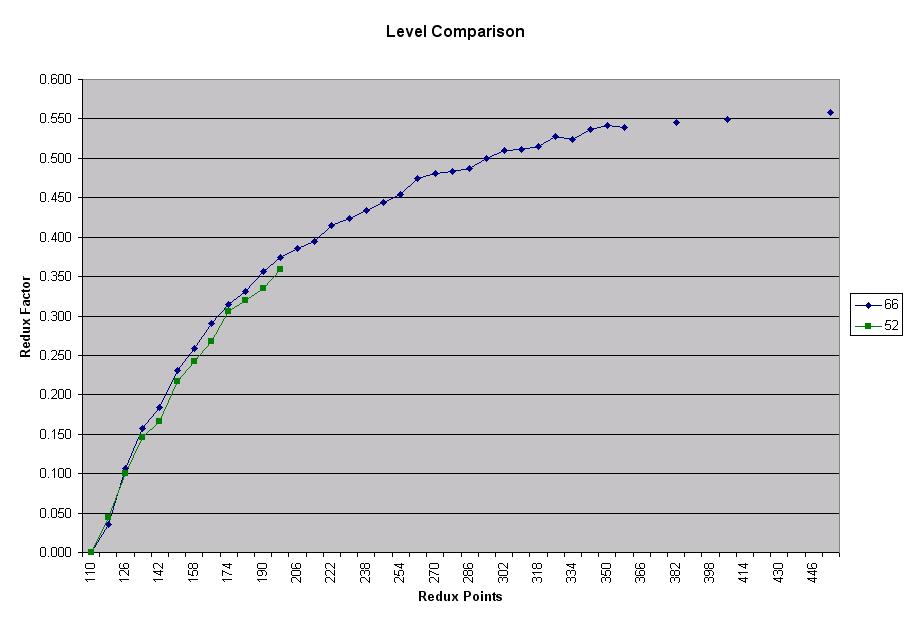Redux: Difference between revisions
VANKRASN39 (talk | contribs) m (add category) |
SPYRIDONM1 (talk | contribs) No edit summary |
||
| Line 65: | Line 65: | ||
There is another theory of redux that is considerably more complex. In brief, it posits the existence of two redux factors (RF1 and RF2), the former being used in crit divisor depression calculations and the latter in most AS/DS combat resolutions. |
There is another theory of redux that is considerably more complex. In brief, it posits the existence of two redux factors (RF1 and RF2), the former being used in crit divisor depression calculations and the latter in most AS/DS combat resolutions. |
||
==See Also== |
|||
*[[Redux, and Things (saved post)]] |
|||
[[category:Skills]] |
[[category:Skills]] |
||
Revision as of 13:45, 31 May 2014
Redux, also known as Damage Reduction, is the ability of a character to resist physical damage more effectively, resulting in less health loss, as well as reducing or even negating what should have inflicted a wound. This is not to be confused with Defensive Strength (DS), which reduces the endroll in the combat formula. Redux does not come into play until the character is successfully hit by an AS based attack, at which point it will then reduce the ensuing damage correspondingly.
Redux Points
Redux is initially achieved by training in physical skills, and the total reduction is increased by additional training in these skills. Some skills provide more redux benefit than others, and are divided into primary, secondary, and tertiary skills. Primary skills effectively provide one "point" towards redux, secondary skills provide 0.4 points, and tertiary provide 0.3 points.
The threshold for achieving redux is approximately 109 redux points, however, at lower levels, this threshold is higher. For example, a level 22 character with 114.8 did not have sufficient points to gain redux but did with 115.8 points.
Character's will receive the following message when checking out of a local inn indicating that they do not have redux. If this message is not displayed then the character does have redux.
Primary Skill: 1.0 point per rank
Secondary Skills: 0.4 points per rank
Tertiary Skills: 0.3 points per rank
- One-Handed Edged Weapon Training
- One-Handed Blunt Weapon Training
- Brawling Weapon Training
- Polearm Weapon Training
- Ranged Weapon Training
- Thrown Weapon Training
- Two-Handed Weapon Training
Spell Penalty
Training in spells will reduce a character's redux. This is a gradual reduction based on the number of spell ranks trained, but the exact formula is not currently known. There is some research which indicates that at one spell rank per level the penalty is approximately 34-38%. At two ranks per level the penalty is 100%.
Example: A level 100 character with a redux factor of .560 (56%) decides to train 100 spell ranks. This character can expect that the spell penalty will lower their redux factor from .560 to approximately .360 (36%). With 200 spell ranks or greater they will lose their redux entirely.
Note: Training in magic skills other than spells has no effect on redux.
Calculating Redux
Examples
Damage and Critical Padding
Damage and Critical Weighting
Critical Damage Ratio (CDR)
It is not currently possible to determine one redux factor value for any given character. A recently discovered relationship that helps decrease the deviations from average redux factor is to take into account critical damage ratio (CDR), defined as reduced crit damage divided by total reduced damage. The amount CDR deviates from its average has an effect of opposite sign multiplied by .25 on redux factor.
Redux Graph
It is also not currently possible to determine the redux factor from redux points alone. The relationship is roughly logarithmic and somewhat level-dependent, as the following graph indicates:
Armor Critical Divisor
Redux is also known to deflate the critical divisor. Roughly, the crit divisor is deflated by RF/3.
Note: it is never the case that a character is worse off for having redux.
There is another theory of redux that is considerably more complex. In brief, it posits the existence of two redux factors (RF1 and RF2), the former being used in crit divisor depression calculations and the latter in most AS/DS combat resolutions.
